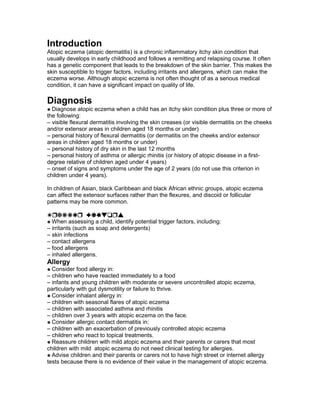Eczema, also known as atopic dermatitis, is a chronic inflammatory skin condition that is common in children under 5 years old. It causes red, itchy patches that flare up due to triggers like skin irritants, allergens, stress, and skin infections. While eczema is usually not serious, it can significantly impact quality of life. Diagnosis involves visible rashes in skin folds or other areas plus a personal or family history of eczema, asthma, dry skin or other atopic conditions. Potential trigger factors and signs of bacterial infection should be assessed and treated appropriately.



![• Immunological abnormalities and activation of complement are involved.
• There is also an ability to activate the alternative complement pathway.
• Malassezia furfur appears to be the species associated with infantile seborrhoeic
dermatitis.[1]
Epidemiology
Seborrhoeic dermatitis is extremely common in infants. Many children with the condition
are not brought to the attention of the medical services and so the precise incidence is
unknown.
Presentation
Seborrhoeic dermatitis presenting in infancy is a very common condition which may be
brought to the attention of the health visitor or GP.
In the majority of cases it is a benign self-limiting condition which usually clears
spontaneously during the first 12-24 months of life but, in a small number, it can be
particularly troublesome and require treatment.
Seborrhoeic dermatitis occurs most commonly in the lipid-rich areas of skin and, in
infants, occurs predominantly on the scalp and upper face, producing an appearance
which may give rise to some concern from parents.
Cradle cap is very common and usually appears in the first few weeks of life. There are
greasy, yellow scaling patches that may eventually coalesce to a thick, scaly layer. The
condition is not itchy and the child is not distressed by it.
Other findings may include:
• Plaques around the ears, nose and eyebrows.
• Sharply demarcated brightly erythematous rash in the groin and perianal area
(may be confused with ammoniacal dermatitis or candidiasis).
• Itching.
• Excoriation of the skin (where the child has scratched).
• Dandruff.
• Loss of small amounts of hair in the area of the plaques.
• Patches of redness surrounding the plaques.
• Areas of secondary bacterial infection (where scratching has occurred).
Differential diagnosis
• Areas of reddened skin with scales may be mistaken for eczema.
• If the plaques become infected, they may resemble impetigo.
• Psoriasis may cause confusion and can look similar in babies.
• Fungal infections, eg tinea.](https://image.slidesharecdn.com/eczema-130119180919-phpapp02/85/Eczema-4-320.jpg)
